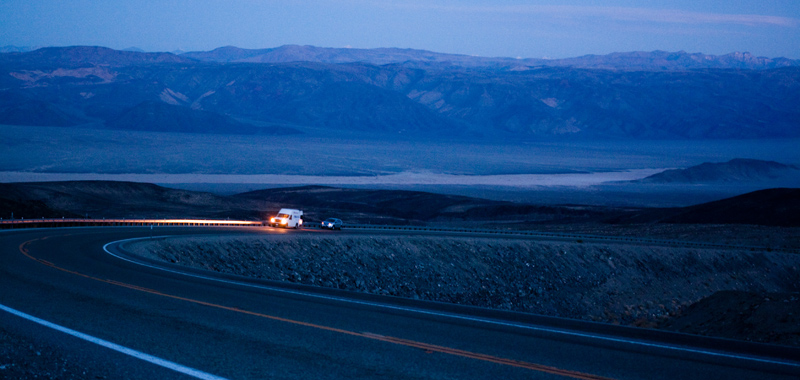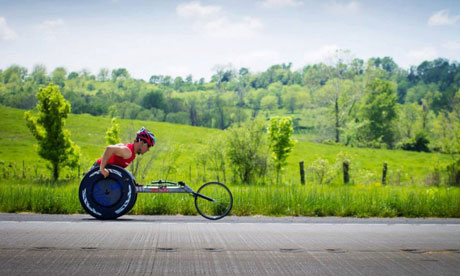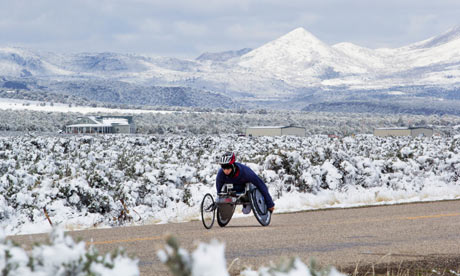Paralympian
Ryan Chalmers has spent the past 10 weeks pushing his way across the
United States in a wheelchair in an attempt to become the first recorded
person to complete the challenge. Chalmers endured early mornings,
inclement weather and an errant heckler during his more than 3,500-mile
journey across the country. He is set to complete the trek the morning
of 15 June in Central Park.
Wake up:

5.30am – Wake up |
Chalmers spends the first 30 minutes of the day in bed before forcing
himself to wake up and push the equivalent of two to three marathons at
a pace of 11-12mph. Chalmers said this is normally a sustainable pace,
but after 1,500 miles of pushing, the pace is harder to maintain.
 To cross the United States by car, foot or any other mode of transportation, you need a certain amount of stamina, dedication and daring.
To cross the United States by car, foot or any other mode of transportation, you need a certain amount of stamina, dedication and daring.
Which might be why paralympian Ryan Chalmers responded to a question about whether he could make the more than 3,000-mile journey by wheelchair with a simple yes.
"I didn't even know how far across the country is. I didn't think too much about it at all," Chalmers told the Guardian. "I just knew I wanted to make a difference and that's the perfect way to do it."
Chalmers, 24, was born with spina bifida, which means he does not have complete use of his legs. He played basketball and track as a kid and focused on track as he aged, eventually representing the US at the 2012 London Olympics.
For the Push Across America, he completes between two to three marathons per day at a pace of 11-12mph. This is a sustainable pace for an athlete of his caliber – except after he's logged more than 2,000 miles and has 1,300 more to go. "Physically, I'm feeling alright," Chalmers said. "Fatigue has definitely kicked in."
He left from Los Angeles on 6 April and has crossed 14 states since then to get to New York. The Guardian spoke to Chalmers when he was in Forsyth, Illinois – more than 2,000 miles into his trek.
To prepare physically for the race, he only had to add a couple extra workouts. The mental preparation was equally important. Chalmers said his coach told him: "There's not really a way you can get used to being in a racing chair for six to eight hours. Your legs are going to hurt, your back's going to hurt. You just have to mentally get over it."
Chalmers spends most of his hours on the road alone, though people also line the roadways to support him. Though, the day we spoke he had been flipped off for the first time.
"A lot of stuff can go through the mind during that time and you've just got to focus yourself every once in a while, not let yourself talk to yourself too much about some of the crazy stuff that's going on and really focus on the reason why we started the push in the first place," Chalmers said.
In 2009, Chalmers was having coffee with Roger Muller, founder of Stay Focused, an organization that works with disabled youth, when Muller casually asked if Chalmers would be willing to cross the US by wheelchair. Chalmers immediately accepted.
 Chalmers spends most of his hours on the road alone. Photograph: Parker Feierbach
Muller founded Stay Focused after a sucba-diving trip with his
brother, who became a paraplegic from injuries sustained in the Vietnam
war. Seeing his brother's positive experience with the activity inspired
him to start a non-profit that offers teenagers with disabilities the
opportunity to get scuba certification.
Chalmers spends most of his hours on the road alone. Photograph: Parker Feierbach
Muller founded Stay Focused after a sucba-diving trip with his
brother, who became a paraplegic from injuries sustained in the Vietnam
war. Seeing his brother's positive experience with the activity inspired
him to start a non-profit that offers teenagers with disabilities the
opportunity to get scuba certification.
Chalmers interned with the group after participating in the certification program. "I jumped on the opportunity right away because I'm able to put my passion of wheelchair racing and the organization together to make a difference," Chalmers said.
There are six people total on the road with Chalmers, providing a variety of support-crew activities including physical therapy, route planning and chair maintenance.
A challenge for the entire crew is the constant presence of two film-makers, who are making a documentary. Chalmers has two cameras constantly attached to his chair, the film-makers shoot footage constantly and a mic captures his interviews with reporters and conversations for crews. Sometimes crew members take dinner on their own to get a break from the exposure.
"It's definitely been something I've had to get used too, but it's been good," said Chalmers, who didn't know there would be a camera crew until a week and a half before the push began.
Chalmers arrives in Central Park in New York at 10am on Saturday, where his supporters have organized an event to commemorate his accomplishment. He will be escorted into the city by the New York police department and supporters are encouraged to gather at the West 67th Street entrance of Central Park in Manhattan. Supporters are invited to watch his arrival starting at 9.30am on 15 June
Ryan Chalmers treks across US – by wheelchair: 'You've just got to focus'
Paralympian describes physical and mental challenges of logging six to eight hours per day to reach 3,000-mile goal

Ryan Chalmers completes the equivalent of two to three marathons per day. Photograph: Parker Feierbach
Which might be why paralympian Ryan Chalmers responded to a question about whether he could make the more than 3,000-mile journey by wheelchair with a simple yes.
"I didn't even know how far across the country is. I didn't think too much about it at all," Chalmers told the Guardian. "I just knew I wanted to make a difference and that's the perfect way to do it."
Chalmers, 24, was born with spina bifida, which means he does not have complete use of his legs. He played basketball and track as a kid and focused on track as he aged, eventually representing the US at the 2012 London Olympics.
For the Push Across America, he completes between two to three marathons per day at a pace of 11-12mph. This is a sustainable pace for an athlete of his caliber – except after he's logged more than 2,000 miles and has 1,300 more to go. "Physically, I'm feeling alright," Chalmers said. "Fatigue has definitely kicked in."
He left from Los Angeles on 6 April and has crossed 14 states since then to get to New York. The Guardian spoke to Chalmers when he was in Forsyth, Illinois – more than 2,000 miles into his trek.
To prepare physically for the race, he only had to add a couple extra workouts. The mental preparation was equally important. Chalmers said his coach told him: "There's not really a way you can get used to being in a racing chair for six to eight hours. Your legs are going to hurt, your back's going to hurt. You just have to mentally get over it."
Chalmers spends most of his hours on the road alone, though people also line the roadways to support him. Though, the day we spoke he had been flipped off for the first time.
"A lot of stuff can go through the mind during that time and you've just got to focus yourself every once in a while, not let yourself talk to yourself too much about some of the crazy stuff that's going on and really focus on the reason why we started the push in the first place," Chalmers said.
In 2009, Chalmers was having coffee with Roger Muller, founder of Stay Focused, an organization that works with disabled youth, when Muller casually asked if Chalmers would be willing to cross the US by wheelchair. Chalmers immediately accepted.
 Chalmers spends most of his hours on the road alone. Photograph: Parker Feierbach
Muller founded Stay Focused after a sucba-diving trip with his
brother, who became a paraplegic from injuries sustained in the Vietnam
war. Seeing his brother's positive experience with the activity inspired
him to start a non-profit that offers teenagers with disabilities the
opportunity to get scuba certification.
Chalmers spends most of his hours on the road alone. Photograph: Parker Feierbach
Muller founded Stay Focused after a sucba-diving trip with his
brother, who became a paraplegic from injuries sustained in the Vietnam
war. Seeing his brother's positive experience with the activity inspired
him to start a non-profit that offers teenagers with disabilities the
opportunity to get scuba certification. Chalmers interned with the group after participating in the certification program. "I jumped on the opportunity right away because I'm able to put my passion of wheelchair racing and the organization together to make a difference," Chalmers said.
There are six people total on the road with Chalmers, providing a variety of support-crew activities including physical therapy, route planning and chair maintenance.
A challenge for the entire crew is the constant presence of two film-makers, who are making a documentary. Chalmers has two cameras constantly attached to his chair, the film-makers shoot footage constantly and a mic captures his interviews with reporters and conversations for crews. Sometimes crew members take dinner on their own to get a break from the exposure.
"It's definitely been something I've had to get used too, but it's been good," said Chalmers, who didn't know there would be a camera crew until a week and a half before the push began.
Chalmers arrives in Central Park in New York at 10am on Saturday, where his supporters have organized an event to commemorate his accomplishment. He will be escorted into the city by the New York police department and supporters are encouraged to gather at the West 67th Street entrance of Central Park in Manhattan. Supporters are invited to watch his arrival starting at 9.30am on 15 June

No comments:
Post a Comment
Thanks for your comment, keep reading our news and articles